|
Dubbo, NSW, Australia - 13th August 2008
By: sararingham
Next stop was Dubbo...
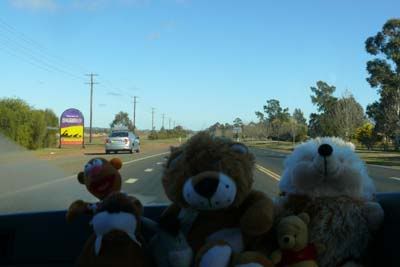
We all were sure happy to stand up for the first time in 2-1/2 hours our legs were sure tired from sitting that long. We stopped, did two mystery shops, and then was off to do the thing we were set off to doing. We first stopped at Red Rooster and got something to eat and headed off. A very short drive later we were there... the entry looked like the entrance to Jurassic Park and then Sara told us it's Taronga's Western Plains Zoo. She told us that this zoo has a climate very similar to the African climate so they breed endangered animals... this zoo is so big that you drive through most of it, park get out an see the animals, walk on trails and everything. Sara said the zoo is over a 6 kilometre radius, so there's LOTS of room for the animals to walk around...
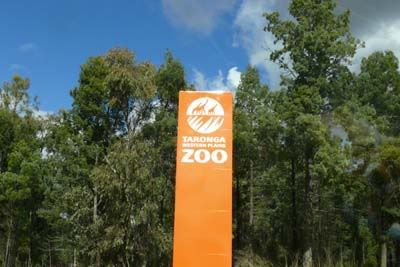
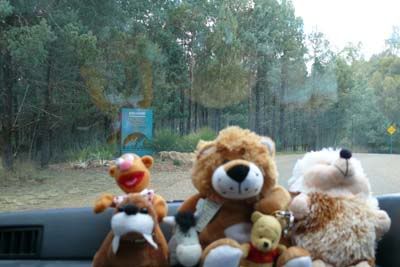
First thing we see when we get into the main part of the zoo are the African Wild Dogs there was only two in the exhibit as the sign said that they were currently introducing a female to the pack. They were quite active and running around at the back of the exhibit so it was hard to get myself in a photo with them.

You'll find most of the animals in the zoo aren't close it doesn't look good for me to be in the photo as I'll be just a blurred mess but it was still an amazing adventure... before we moved onto the next animal we decided to have a look around one of the huge ponds they had throughout the zoo... there was some Australian white ibises there, Sara took a photo as there were masses of them - they weren't part of the zoo, but they obviously liked their living quarters...

It's common to find these guys all over the place including the dump, all over Sydney... they're known like pigeons are known throughout the world... but much bigger...
The next animals were the Arabian Camel and the Barbary Sheep. They were both in the same enclosure. You could see the camels straight away, but there was no Barbary Sheep, hmmm... I wonder where they could be...G]
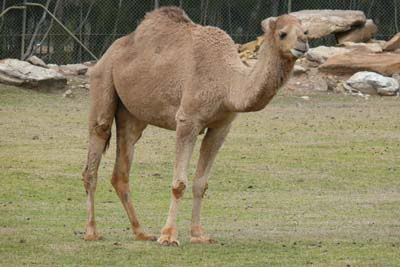
...then we had a closer look at the other side of the enclosure and we noticed they were in the rocky area... how strange, they blended in SO well I could barely notice them... Sara had to zoom all the way in on her camera to get this photo... as we went back to the car they all stood up and were walking around... Sara got some more photos, but there's so much to get to already we moved on...
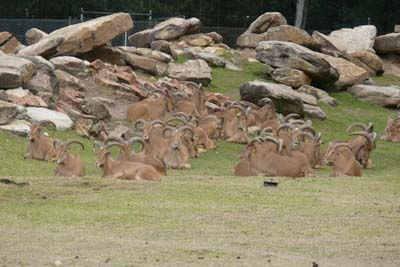
Sara took a few photos of some of the signs for you to read if you wanted to... the Arabian Camel sign says:
Life In The Desert... Camels are well suited to life in the desert. By producing dry faeces and very little urine or sweat, they can survive for a long time without water. When good food is available camels store fat in their hump. When food is scarce, they use this as an energy supply. They will also eat thorns, dry vegetation and saltbush that other animals avoid.
Life In Australia... Camels were introduced to Australia in the 1840's to carry heavy loads and passengers into the dry heat of the country. Many survived and are now in higher numbers in the Australian desert than in the wilds of Arabia. There are no known wild Arabian Camels left.
The Arabian Camel's wild ancestor is unknown - it is presumed to be extinct.
The sign for the Barbary Sheep reads:
Barbary Sheep are the only wild sheep that live in Africa. They are an important source of meat which is valuable to the desert economy. In some areas, their numbers have dropped so low that they are now considered vulnerable.
Rocky hills, mountains and stony plains don't offer much protection from predators so Barbary Sheep rely on camouflage. If threatened they stand still and their sandy colour coat blends with the desert habitat. Their hooves have soft centre pads with hard-rimmed edges that can grip any ledge - great for scampering up sheer cliffs.
Whilst we were watching the animals we saw some Australian birds, Sara got a photo of some of them as some of them are very pretty unique birds known to Australia... first we saw the Grass Parrot, they're very pretty...
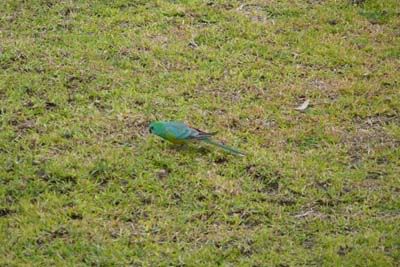
...and then near the parrot we saw two Crested Brozewing's which are Australia's native pigeon... Sara has some she feeds in her yard all the time... they're quite pretty for pigeons I think. :-)

Onto the next animal, this animal was something that is unique to Australia, the only Australian zoo known to have them and breeds them... the critically endangered Black Rhino...

...the next animal it was quite exciting as you see when we were driving up they were all quite close as they were eating so Sara was able to get some really nice close up shots... here are the Giraffes.
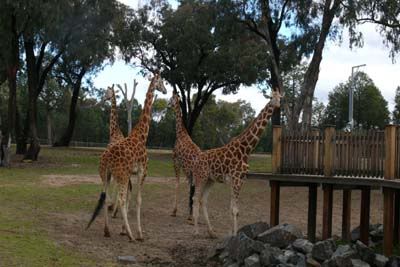
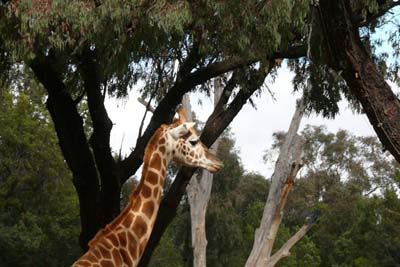
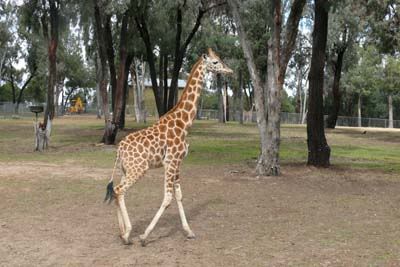
Once we watched the giraffes for a while and they all moved on we went to the next stop, the African Elephants... they also were eating, some branches... how strange is that? There was one there that was HUGE... Daniel was saying how the one closest to us, and in most of the photos was one of the oldest in Australia. He was lucky enough to be able to feed him a few years back...



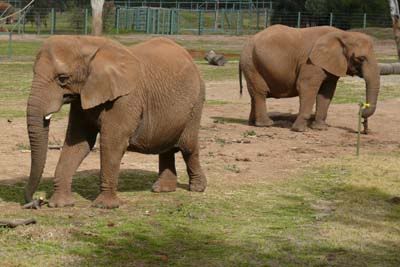
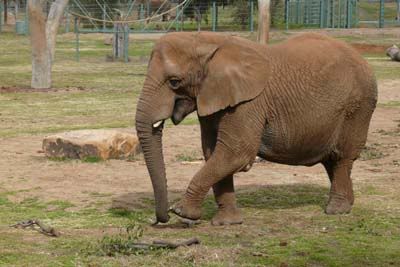
We next stopped at the White Rhinos which are almost threatened, but no where near extinction like the Black Rhino... there were quite a few there, and even a baby, in the way back lying down... so cute!...
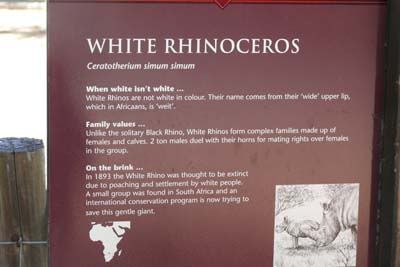
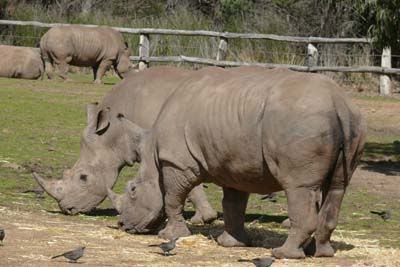
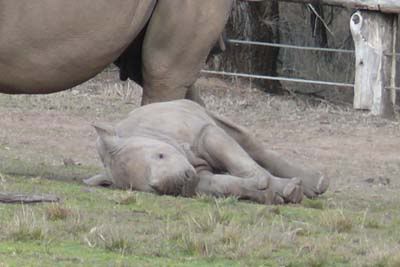
Here's what the sign for the white rhino says...
When white isn't white... White Rhinos are not white in color. Their name comes from their 'wide' upper lip, which in Africaans, is 'weit'.
Family Values... Unlike the solitary Black Rhino, White Rhinos form complex families made up of females and calves. 2 ton males duel with their horns for mating rights over females in the group.
On the brink... In 1893 the White Rhino was thought to be extinct due to poaching and settlement by white people. A small group was found in South Africa and an international conservation program is now trying to save this gentle giant.
I quickly turned around noticing these birds seemed to be following us all throughout the zoo, they must want some food, sadly I didn't have any food to give them but he was happy to pose for a photo, I thought they were quite nice looking birds... kind of had an eagle appearance with the bone structure...
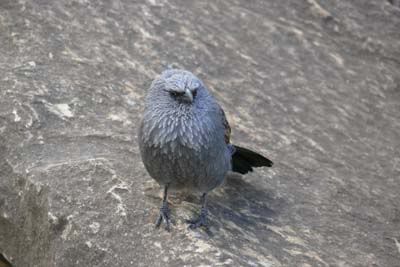
Right across from the White Rhinos we visited some more water animals, although these guys weren't active at all when we were visiting them they were the Common Hippopotamus...

...once we left though they actually became quite active and were swimming around and making growling type noises, sadly Sara wasn't able to get any more photos beyond this one of the hippo... they seemed to dive a lot when Sara went to take a photo... I guess they didn't want their photo taken... oh well...
...as we were about to go to the next animal... we heard this really loud screeching noise, we went to investigate... after a lot longer of a walk than we thought it would be we ended up at the Siamang Primates there was a family of three there and they were making such noise... but they were quite funny, and it grew quite a large crowd as well!...
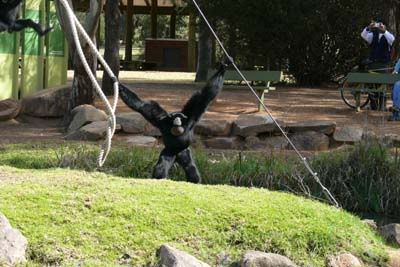
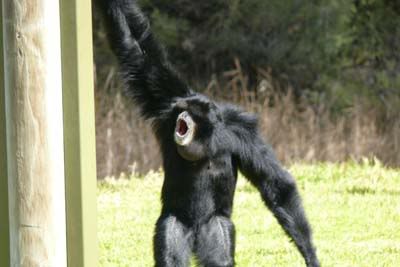
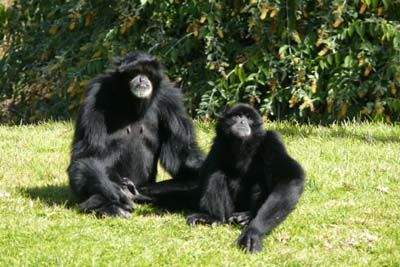
...we could hear them across the zoo the rest of the time we were visiting the zoo too - pretty fun to watch!...
On the way back from visiting the noisy monkeys we saw some more calm monkeys that didn't quite have a crowd, like at all... so we decided to watch them for a little while, they were the White Handed Gibbon...
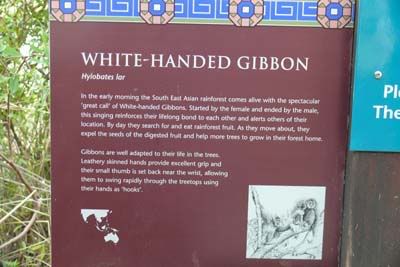
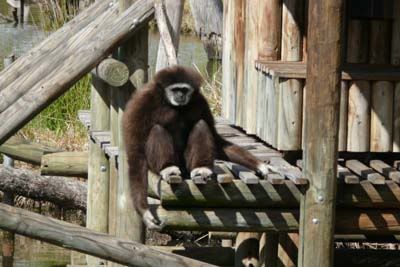
The sign for the white-handed gibbon says:
In the early morning the South East Asian rainforest comes alive with the spectacular 'great call' of the white-handed gibbons. Started by the female and ended by the male, this singing reinforces their lifelong bond to each other and alerts others of their location. By day they search for and eat rainforest fruit. As they move about, they expel the seeds of the digested fruit and help more trees to grow in their forest home.
Gibbons are well adapted to their life in the trees. Leathery skinned hands provide excellent grip and their small thumb is set back near the wrist, allowing them to swing rapidly through the treetops using their hands as 'hooks'.
...next stop before finally going back to the car we saw some Ruffed Lemur... these guys were quite playful, especially when the zoo keepers came in to feed them and clean out their enclosure, it was pretty cute to watch...
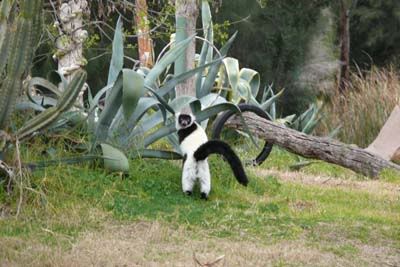
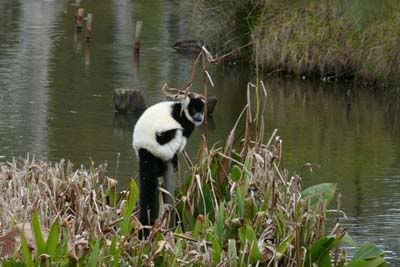
As we were coming back to what we originally intended to see next we saw another Australian native bird... it's called a Willy Wagtail they're cute little birds that look like they're wearing a tuxedo...
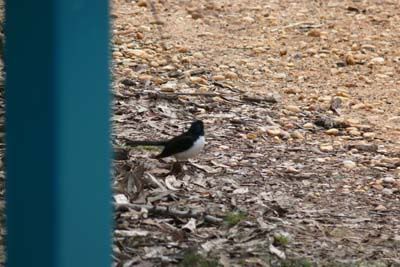
...finally back on track again, the next animal is known as the largest antelope in the world, it's called the Common Eland...
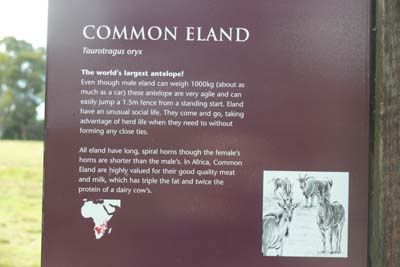
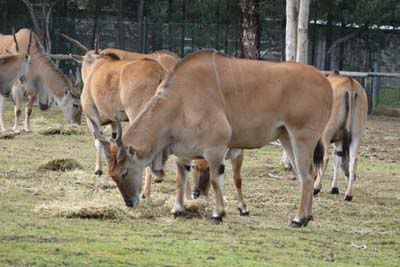
The common eland sign reads:
The world's largest antelope! Even though male eland can weight 1000kg (about as much as a car) these antelope are very agile an can easily jump a 1.5m fence from a standing start. Eland have an unusual social life. They come and go, taking advantage of herd life when they need to without forming any close ties.
All eland have long, spiral horns though the females horns are shorter than the male's. In Africa, common eland are highly valued for their good quality meat and milk, which has triple the fat an twice the protein of a darily cow's.
...time to move onto the next animal... this just happened to be the fastest land animal in the world... the Cheetah... fast? really? all these guys were doing was lounging around... they looked pretty happy though!
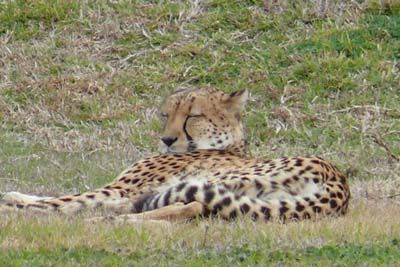
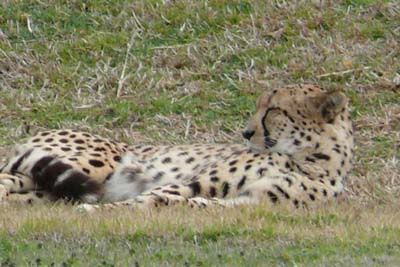
We turned around and took another little walk down another trail towards the centre of the zoo when we came upon the strange looking Bongo's... although the animals so far have been pretty good at posing for the photos, these guys wanted nothing of it... it was very hard to get a photo with them looking at us... they must be pretty stubborn little (or not so little) guys!
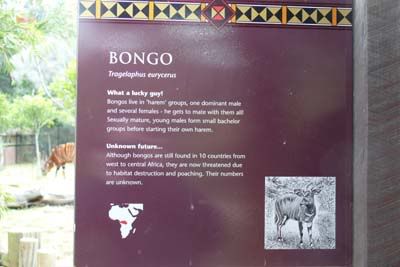
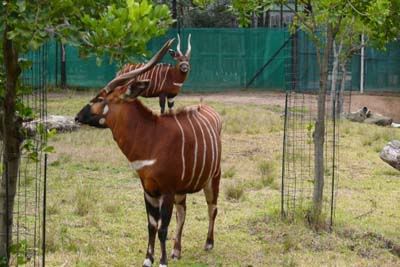
Here's what the bongo sign reads:
What a lucky guy! Bongos live in 'harem' groups, one dominant male and several females - he gets to mate with them all! Sexually mature, young males form small bachelor groups before starting their own harem.
Unknown future... although bongos are still found in 10 countries from west to central Africa, they are now threatened due to habitat destruction and poaching. Their numbers are unknown.
Whoops... it was about time to go to the front desk to ask a few questions so we did a quick run through the rest of the zoo before going back through... but on the way through we stopped and visited some more animals... the stay wasn't as long for the rest of the animals for the time being though...
So on the way there the first stop we made was for the Fallow Deer it was amazing how small they were... they even had the spots like a baby deer in America has... how cute!...
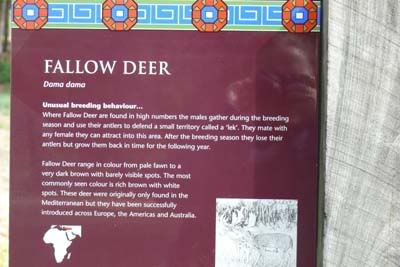
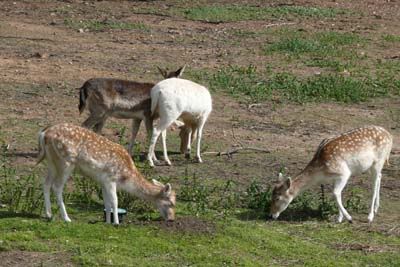
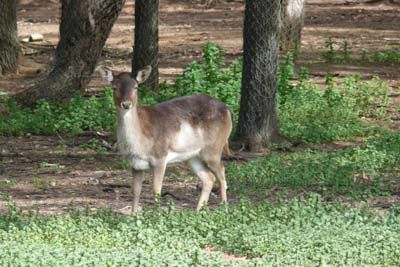
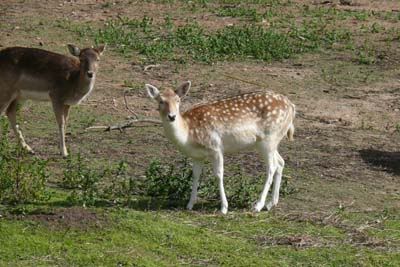
The fallow deer sign says:
Unusual breeding behavior... where fallow deer are found in high numbers the males gather during the breeding season and use their antlers to defend a small territory called a 'lek'. They mate with any female they can attract into this area. After the breeding season they lose their antlers but grow them back in time for the following year.
Fallow deer range in color from pale fawn to a very dark brown with barely visible spots. The most commonly seen color is rich brown with white spots. These deer were originally only found in the Mediterranean but they have been successfully introduced across Europe, the America's and Australia.
...We seemed to be in the hooved section of the zoo, as the next stop was the strange looking Persian Onager, they just looked like tan colored donkeys to me, but obviously they're quite different...

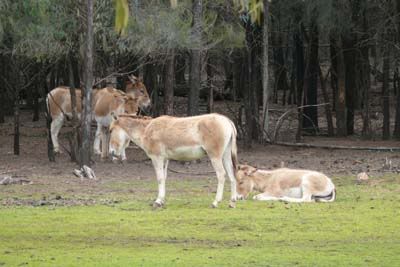
As the Persian Onager sign reads:
It's not a donkey... the Persian onager is the fastest member of the horse family. It is able to sustain a 50km/hr pace and is capable of short bursts at 70km/hr. In the flat, Iranian desert, herds of onager feed on grass and succulent plants. They travel long distances to reach feeding grounds in the winter and to find summer watering holes.
Modern firearms and competition with life stock for food and water have led to a decline in numbers in the wild. They are now only found in three desert regions where they have been protected for 30 years.
...next was the Asiatic Water Buffalo... Sara said that the last time they came through it was the middle of Summer and they were all crowded into the water, this time they were out of the water but were relaxing together eating... so still not extremely active, but it was amazing how huge they are!
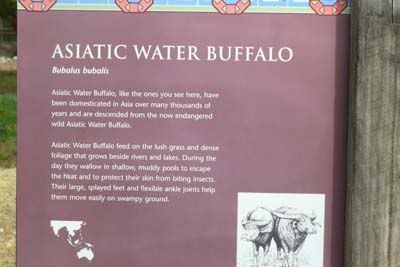

This is what the Water Buffalo sign reads:
Asiatic Water Buffalo, like the ones you see here, have been domesticated in Asia over many thousands of years and are descended from the new endangered wild Asiatic Water Buffalo.
Asiatic Water Buffalo feed on the lush grass and dense foliage that grows besides rivers and lakes. During the day they wallow in shallow, muddy pools to escape the heat and to protect their skin from biting insects. Their large splayed feet and flexible ankle joins help them move easily on swampy ground.
...as we were nearing the end of the hooved animals we had a visit with some Sambar and Banteng. There wasn't many to be seen but I got both of them in the same photo, the one near the front, the larger one is a Banteng and the one towards the back is the Sambar... here's some information about them...

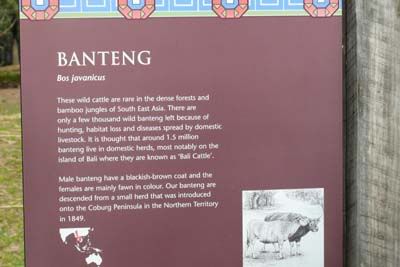
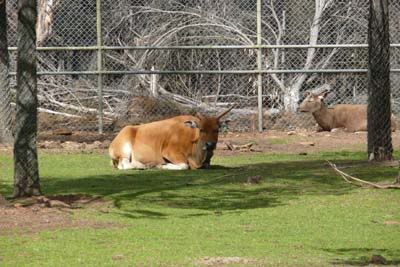
Here's what the Sambar sign says:
Raising the alarm... when alarmed, Sambar signal to other deer by stamping their front feet and raising their tails to show the white underside and rump. These large, woodland deer also make a 'belling' call when they sense a predator. They are partial to water and are often found bathing and feeding in lakes, rivers and marshes.
Male sambar grow and shed their antlers each year. They can grow up to a meter long in less than 5 months! They recognize each others antlers as a signal of strength - bigger antlers signal a stronger individual. Usually, a male sambar won't compete for females with another male whose antlers are larger than his.
...and the Banteng sign says:
These wild cattle are rare in the dense forests and bamboo jungles of South East Asia. There are only a few thousand wild banteng left because of hunting, habitat loss and diseases spread by domestic life stock. It is thought that around 1.5 million banteng live in domestic herds, most notably on the island of Bali where they are known as 'Bali Cattle'.
Male banteng have a blackish-brown coat and the females are mainly fawn in color. Our banteng are descended from a small herd that was introduced into the Coburg Peninsula in the Northern Territory in 1849.
...next stop was the famous Australian animal, the Emu... we all got a photo with them...
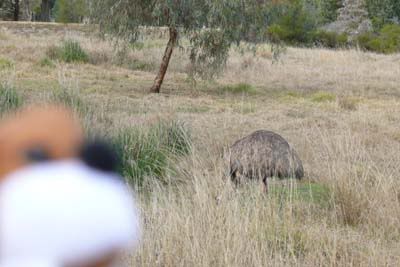
...and here's a better photo of one of the emu's, they're quite big birds... and we actually have them wild in the area where I'm staying with Sara although not very common they have been seen in farmers paddocks...

...whoa it's coming much closer to 2pm than I thought it was... we gotta get off to the information desk... when we got there... there was a peacock...

...kind of startled us all as we weren't expecting it... we then realised that what we were going to the information desk for was canceled for today... which was very sad...
...So instead we took a break and ate something then continued on... where we sat down to eat our lunch were some more crazy animals... some [url=http://en.wikipedia.org/wiki/Ring_tailed_lemur]Ring-Tailed Lemur's... they were all grouped up and we were pretty close them actually only a bit of water separated us from them...
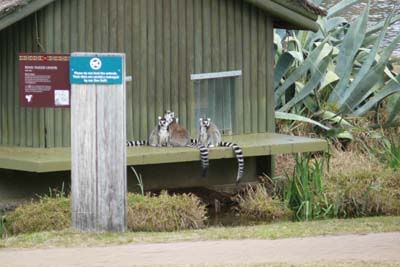
...well that wasn't all for the day we were only around half way through the zoo, but sadly Sara's memory card needed to be changed to a much larger one... so we didn't get anymore photos able to be uploaded for today... watch for an update in the near future with lots more Australian animals... this was quite a fun day today. I can't wait to tell you all about the rest of it! Write again soon!
|
|
 Posted Aug 14, 2008, 1:44 pm Last edited Jul 22, 2009, 10:21 am by sararingham
[Quote] Posted Aug 14, 2008, 1:44 pm Last edited Jul 22, 2009, 10:21 am by sararingham
[Quote]

|
|
|



